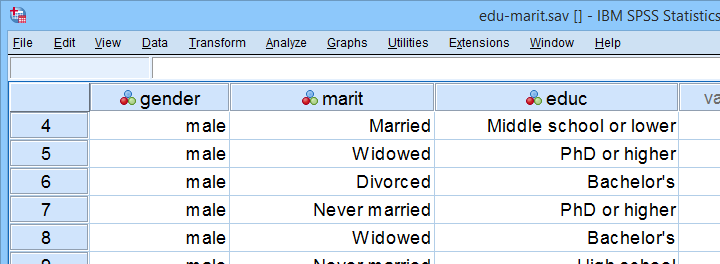

In the crosstab table it is clear that Protestants and Catholics are much more likely to report a belief in the afterlife than are Jews or Nones. 05 which shows that there is a relationship between one’s religion and their belief in the afterlife.įinally, we interpret the test in everyday terms, which also means we look more closely at the crosstab table as well. As seen in the table below, the Chi-Square significance value is. 05, there is a relationship between the variables based on the level of confidence we stated in the beginning. (2-sided)” for the Pearson Chi-Square statistic is less than. Select the independent variable (relig) to go in the column and the dependent variable (postlife) to go in the row.Īs we stated in the beginning, our alpha is. Once you click Crosstabs, a window will pop up where you will enter your chosen variables to be tested. To run the test, select: Analyze → Descriptives → Crosstabs. For this example religion is the independent variable and belief in the afterlife is the dependent variable.

For this example we will use religion (relig) and belief in the afterlife (postlife). You must have two nominal variables from a single sample that you can use to see if there is a relationship between them.

To do a Chi-Square test in SPSS, complete the following steps: The hypothesis we will test in this chapter is whether or not there is a relationship between religious affiliation and belief in the afterlife. To calculate Chi-Square, we use a cross-tabulation, crosstab for short, which shows the frequencies of joint occurrences between two variables. An ordinal variable is similar to a nominal variable, but the categories can be put in an order (e.g., ranked highest to lowest). To reiterate, a nominal variable is one that is only measured by naming categories such as class, quality or kind. In the syntax below, the get file command is used to load the. These data were collected on 200 high schools students and are scores on various tests, including science, math, reading and social studies (socst).The variable female is a dichotomous variable coded 1 if the student was female and 0 if male. If you have to use a numeric value, you are going to either need to manage numeric missingness in Excel or you need to translate the data as you read it in to SPSS.The Chi-Square test is used when trying to find a relationship between two nominal or ordinal variables. This page shows an example of logistic regression with footnotes explaining the output.
Spss chisquare code#
If you have to do calculations in Excel, you should probably use that.īut if you're going to take it into SPSS you also need to worry about what SPSS can do with missing values if it has the ability to code missingness non-numerically, I'd suggest you use it. (But pause after typing the "A" so you can see the description of the function). In Excel, there's the function NA() which returns the missing value. In the 1960s, maybe even into the 1970s when there was no suitable alternative it made some sense, and packages (like SAS or SPSS) developed mechanisms to incorporate dealing with numerically-coded missingness.īut such an approach was always risky, and ever since missing values were actually codable in other things, that advice becomes outdated more generally. The psych textbook is giving you very bad advice there. The Psych textbook I'm using suggests a score of 99 or 999 for missing values, so if I put 99 for a missing value in excel and I am adding those scores together, is it going to affect my scores in Excel? 'perceived class' I have 4 speakers producing 2 separate guises and I thought the easiest way to ensure that my scores were above 5 for the chi-square for independence test would be to simply add all the scores per participants for each guise, for example, all 4 of participant 1's 'perceived class' scores for the 2 guises etc. My question is, do responses such as these count as missing values in my data? Also, is there a specific command in SPSS to ensure that you 'exclude cases pairwise' or is it an automatic thing?Īlso, In order to set up my data set on SPSS, I have ordered my data in Excel, before I copy it across to SPSS. Because of this, some of my responses are 'unknown' or sometimes the participants have put 'don't know' as a response. I'm conducting the above tests on my data, where my participants used Likert scales to analyse the personality traits of 2 guises produced by speakers from Devon. I'm a postgraduate student, doing a accent perception study, this is my first time using SPSS!


 0 kommentar(er)
0 kommentar(er)
